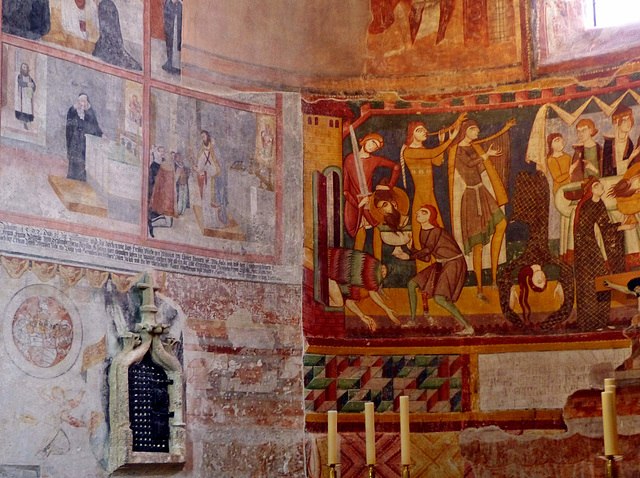Location
Lat, Lng: 46.629841, 10.448355
You can copy the above to your favourite mapping app.
Address: Abbey Of Saint John
You can copy the above to your favourite mapping app.
Address: Abbey Of Saint John
Keywords
Authorizations, license
-
Visible by: Everyone -
All rights reserved
-
358 visits
Val Müstair - St. Johann


Many churches, chapels and abbeys all over continental Europe claim to be founded by Charlemagne.
Saint John Abbey in the village of Müstair (= monasterium) is - most likely - founded in deed by Charlemagne or a bishop under Charles´ order around 774. At that time Charlemagne fought war against the Langobards in Northern Italy and needed save and secure passes over the Alps for his army. Fortified monasteries played an important role in this strategy.
Dendrochronological surveys found out, that some of the beams used for the construction cut around 775, what is, when Charlemagne´s soldiers conquered the Lombardy.
The "Benediktinerinnenkloster St. Johann", today still a Benedictine nunnery, is since 1983 a UNESCO World Heritage Site.
Most spectacular is the interior of the convent´s church, that meanwhile serves the parish. It was constructed in Carolingian times, but remodelled later, when it got a late Gothic vaulted ceiling.
Around 1200 all the walls of the church and the apses were covered with Romanesque frescoes. 300 years later, they seemed "old fashioned" - and the walls got whitened. End of the 19th century art historians discovered not only the fresco paintings from 1200, there were wall paintings even from the Carolingian times, dating back to 800. Here, to the right, is a 12th-century-frescoe depicting the death of John the Baptist and a 16th/17th century frescoe to the left..
-
This was my third visit to Müstair in recent years, so I will only upload a few of the fotos I took. In case you are interested, you
will find more in my "Switzerland-album".
Saint John Abbey in the village of Müstair (= monasterium) is - most likely - founded in deed by Charlemagne or a bishop under Charles´ order around 774. At that time Charlemagne fought war against the Langobards in Northern Italy and needed save and secure passes over the Alps for his army. Fortified monasteries played an important role in this strategy.
Dendrochronological surveys found out, that some of the beams used for the construction cut around 775, what is, when Charlemagne´s soldiers conquered the Lombardy.
The "Benediktinerinnenkloster St. Johann", today still a Benedictine nunnery, is since 1983 a UNESCO World Heritage Site.
Most spectacular is the interior of the convent´s church, that meanwhile serves the parish. It was constructed in Carolingian times, but remodelled later, when it got a late Gothic vaulted ceiling.
Around 1200 all the walls of the church and the apses were covered with Romanesque frescoes. 300 years later, they seemed "old fashioned" - and the walls got whitened. End of the 19th century art historians discovered not only the fresco paintings from 1200, there were wall paintings even from the Carolingian times, dating back to 800. Here, to the right, is a 12th-century-frescoe depicting the death of John the Baptist and a 16th/17th century frescoe to the left..
-
This was my third visit to Müstair in recent years, so I will only upload a few of the fotos I took. In case you are interested, you
will find more in my "Switzerland-album".
aNNa schramm, Nicole Merdrignac have particularly liked this photo
- Keyboard shortcuts:
Jump to top
RSS feed- Latest comments - Subscribe to the comment feeds of this photo
- ipernity © 2007-2025
- Help & Contact
|
Club news
|
About ipernity
|
History |
ipernity Club & Prices |
Guide of good conduct
Donate | Group guidelines | Privacy policy | Terms of use | Statutes | In memoria -
Facebook
Twitter











Sehr hübsch ist auch die kleine romanische Kirche *San Gian*, in Schlagrigna (Celerina)
Im Innenraum sind eine reich bemalte Holzdecke von 1478 und Fresken aus der gleichen Zeit erhalten.
Sie gehört mit ihrem Turm zu den bekanntesten Silhouetten des Inntals im Engadin
Martin M. Miles club has replied to aNNa schramm clubein kleine wundervolle romanische Kirche mit unzähligen sehr guten romanischen Fresken.
St. Jakob birgt einen der ältesten Freskenzyklen des deutschen Sprachraums.
de.wikipedia.org/wiki/St._Jakob_in_Kastelaz
Ich habe Südtirol leider viel zu spät "entdeckt"..
haha, das solltest du nun ändern :-)) ... es gibt dort viel zu *entdecken*.
LG aus Perugia ... aNNa*
Sign-in to write a comment.